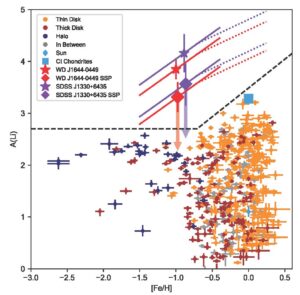UNC Chapel Hill explores new method for measuring galactic evolution of lithium.

Lithium helps power cell phones and computers and stabilize moods. But scientists have been stumped by what’s become of the lithium that was expected from the Big Bang, a discrepancy known as the “cosmological lithium problem.”
They discovered lithium that has been accreted onto old white dwarfs from exo-asteroids. This provides a much better way to analyze lithium history than stars. The oldest white dwarf asteroids will reach back to the earliest planet formation in the Galaxy, tracing element abundances over a very long history—more than we can do from our 4.5B year old solar system.
Our own, Chris Clemens, led the design of the unique spectrograph, which measures how much light is emitted by a white dwarf. White dwarfs are the leftover cores that remain when stars die and they can be surrounded by rocky worlds.
The team was able to measure the chemical make-up of the asteroids, and for the first time identified and measured both lithium and potassium from an extrasolar rocky body.
“Our measurement of lithium from a rocky body in another solar system lays the foundation for a more reliable method of tracking the amount of lithium in our galaxy over time,” Clemens said.
Spite diagram with accreted extrasolar planetesimals from white dwarfs included (adapted from Figure 4 of Kaiser et al. 2020)
Lithium abundance A(Li) is shown as a function of iron abundance [Fe/H]. Logarithmic number abundances for the white dwarfs WD J1644–0449 (red) and SDSS J1330+6435 (purple) are compared to CI Chondrites (blue square, from Lodders, Palme, and Gail 2009) and the Sun (blue circle). Star symbols show the measured atmospheric abundances and diamonds show the inferred accreted body abundances, assuming steady-state accretion phase (SSP) for the white dwarf measurements. Downward faded arrows show corrections to the inferred abundance ratios if the accretion has been in the decreasing phase for 5 Ca sinking times (see Table S4) in the style of Swan et al. 2019. Vertical error bars show 1-σ uncertainties. Sloped lines for each white dwarf represent abundances rescaled to A(Li) using log(Ca/Fe) relations for thick disk (solid lines) and thin disk (dotted lines) Galactic stellar populations, extending over the full range of those populations (see supplement of Kaiser et al. 2020). The white dwarf symbol placement in [Fe/H] is representative and does not depict a preferred value (see supplement). Predicted values for BBN and expected Galactic Li enrichment history are shown by the dashed line (Coc, Uzan, and Vangioni 2014; Grisoni et al. 2019). Measurements of A(Li) and [Fe/H] for a sample of typical stars from the Solar neighborhood (circles) are also shown (Bensby, Feltzing, and Oey 2014; Bensby and Lind 2018).
This figure has been modified from figure 4 of Kaiser et al. 2020 to include the legend from figure 3 of Kaiser et al. 2020. The caption has been modified to include elements of captions for figures 2 and 3 of Kaiser et al. 2020 to allow for clarity in figure 4 as a standalone figure and to spell out references. References using numbered endnotes have been replaced with author-date format or explicit statements to see the supplement.
-For full article please follow the link below
Can white dwarfs help solve the cosmological lithium problem? – College of Arts & Sciences (unc.edu)
-For the article found in the journal Science please follow the link below
-For the article found on the Daily Mail UK please follow the link below
-For some related background information please follow the link below
The Cosmological Lithium Problem – Department of Physics and Astronomy (unc.edu)


